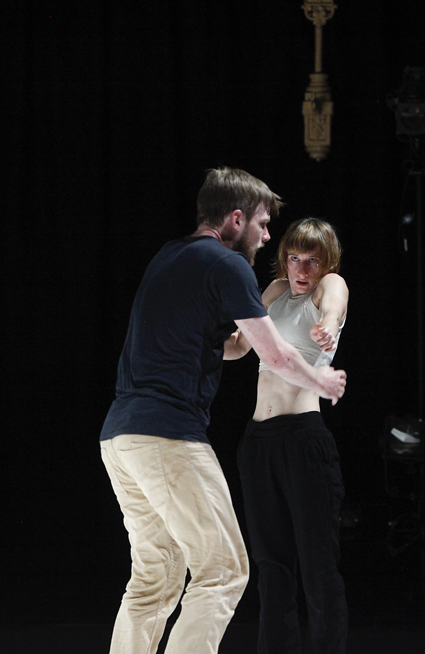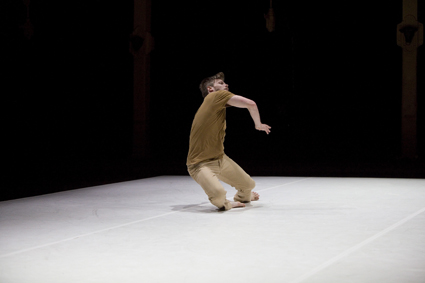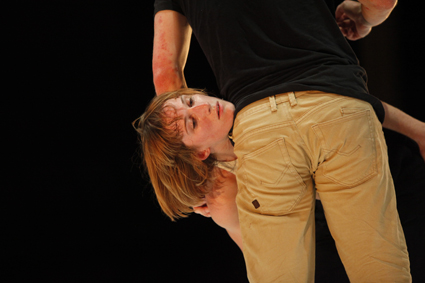the poetry of pain
keith gallasch: stephanie lake, dual

Alisdair Macindoe, Sara Black, Dual
photo Ponch Hawkes
Alisdair Macindoe, Sara Black, Dual
TWO VERY DIFFERENT BODIES, QUITE DIFFERENTLY ATTIRED, TWO SOLOS, SEEMINGLY IDENTICAL, AND A THIRD DANCE BRINGING THE TWO PERFORMERS TOGETHER COMPRISE CHOREOGRAPHER STEPHANIE LAKE’S DIALECTICAL DUAL, A RIVETING PHYSICAL AND AURAL EXPLORATION OF AFFINITY AND DIFFERENCE.
The exactness of the movement in Dual evokes loss of control. In consecutive solos, two humans (Alisdair Macindoe, Sara Black)—they could be animals or trees or wind-whipped newspaper—are buffeted by the unseen but intensely audible forces of Robin Fox’s score. These range from subtle to brutal: bird calls, scratched guitar strings, a gentle Kodaly-ish ostinato, a raging, eerily synthetic storm, heart-palpitating thumps, rushes of industrial sound and a sublimely haunting, oscillating, ever escalating organ tone. The bodies register the impact, vibrating furiously, lurching, bouncing, spinning off-kilter, jolted, falling, slumping, spastically discombobulated. These involuntarily spasms are occasionally countered by determined actions (evasive gestures, vocal noise spat across the traverse stage), but at whom or what are they directed?
For all the suggestiveness of the choreography and the sound score, the solos of Dual are fascinatingly abstract, yielding an immersive poetry of reaction and instability witnessed at close quarters. As well, for all their equivalence, the solos are tonally quite different: Alistair Macindoe’s solid frame and everyday clothing, Black’s lean physiognomy and dance rehearsal wear; a more abrasive score for Macindoe, guitar and bird calls for Black (although they share major sonic motifs); and the distinctive essence of each dancer in and beyond the choreography—Macindoe’s firm, rooted gracefulness and sudden lightness, Black’s elegant, arching sinuousness and quivering vibrancy. These differences yield strikingly discrete solos from similar material, preparing us for what comes next.

Alisdair Macindoe, Dual
photo Ponch Hawkes
Alisdair Macindoe, Dual
Macindoe performs first, then Black. Now the two stand side by side in a rare moment of stillness before solos mutate into duet, where hitherto unidentified forces become increasingly literal without ever quite losing the strangeness of the initial abstraction. The two bodies draw closer and closer, more often in tension and conflict than in intimacy—the unseen forces in the solos now made visibly human, and inevitably, given the tonalities delineated above and the casting of a male and a female dancer, an inescapable aura of heterosexual co-dependency emerges, replete with a final image of, at last, full embrace and apparent resolution.
Without touching, the dancers exert enormous pressure on each other as if by emotional osmosis, so that when touch comes it is electric. Black trips Macindoe up with repeated kicks from behind; Macindoe holds Black to the floor, pushing down on hand, foot and hip and she slowly attempts to rise, reminding us of the deep waves of movement undulating through her body in the solo.
Compounding this complicating togetherness is Robin Fox’s melding of his scores into one for the duet, a strange aural experience that heightens the difference between acoustic and electronic elements (and between the performers) without undercutting the power of the major motifs which suggest the personae of the dancers suffer the same emotional condition. Same, same but different.

Sara Black, Alisdair Macindoe, Dual
photo Ponch Hawkes
Sara Black, Alisdair Macindoe, Dual
Despite the moment in which the pair toss identifiable sounds at each other, Dual is revealed in its third act to be about embodied, unspoken emotional entanglement. Now we look back to the solos that comprise the first two acts and see them for the suffering and bewilderment that they are in a work that is not dance theatre but oscillates finally between the abstract and the literal, making poetry of pain.
Lake’s choreography and the dancers’ execution of it is bracing with its wealth of quickfire detail and powerful recurrent images—evanescent while articulately shaped, adding greatly to Dual’s pervasive sense of lone vulnerability and fragile, raw mutuality. This collaboration between Stephanie Lake and Robin Fox has yielded a memorable, visceral work, at once strange and familiar and brilliantly performed.






